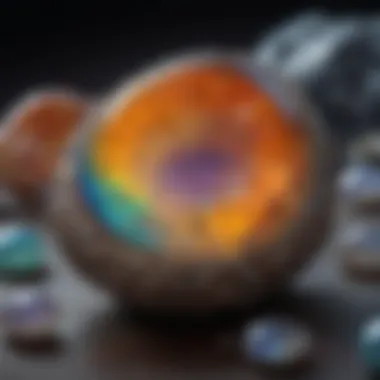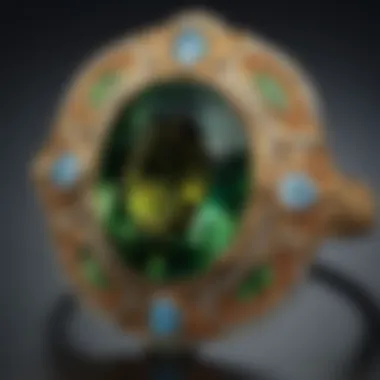Exploring October's Gemstones: Color and Meaning


Intro
October is a month teeming with color, reflecting the richness of autumn leaves and the impending chill of winter. This captivating season is also the home to remarkable gemstones that resonate with the very essence of this time of year. Each stone not only showcases a unique palette but carries with it an intricate tale of history, symbolism, and usage.
In this article, we will delve into October’s gemstones, exploring their magnificent colors, distinctive characteristics, and the cultural narratives woven through their existence. By examining the significance and applications of these stones, we aim to provide a vivid understanding that appeals to gemstone enthusiasts, collectors, jewelry designers, and geology lovers alike.
Gemstone Overview
When we think about October, two prominent gemstones come to mind: Opal and Tourmaline. Each stone possesses its own charm, allure, and significance that goes beyond aesthetics.
Opal
Opal is a gem that paints a story with its display of colors. Ranging from milky whites to deep blacks, its appearance reflects play-of-color phenomena. This occurs when light interacts with its internal structure, producing a myriad of dazzling hues, which can captivate even the most discerning eye.
Physical Properties
- Composition: Opal is a hydrated silica, containing 3-21% water in its structure.
- Hardness: Scores between 5.5 and 6.5 on the Mohs scale, making it relatively softer than many other gemstones.
- Luster: Exhibits a vitreous to waxy luster.
Tourmaline
Tourmaline, with its rainbow of colors, is often regarded as the chameleon of the gemstone world. From vivid pinks to deep greens and even colorless forms, the sheer range is astonishing.
Physical Properties
- Composition: A complex boron silicate containing elements like aluminum, iron, magnesium, and lithium.
- Hardness: Ranges from 7 to 7.5 on the Mohs scale.
- Luster: Typically displays a vitreous to waxy sheen.
"Opal and Tourmaline not only dazzle with their colors but also encompass layers of meaning and utility, making them true treasures of October."
Healing Properties
The belief systems surrounding gemstones often attribute various metaphysical attributes to them, and October's gems are no exception.
Opal
- Metaphysical Attributes: Opal is often seen as a stone of inspiration. It ignites imagination and creativity, promoting self-acceptance and emotional healing. It’s also viewed as a stone of protection, enhancing one's aura.
- Common Uses in Holistic Practices: Practitioners believe Opal can aid in enhancing psychic awareness and dream work. Individuals use Opal in meditation and relaxation to encourage a deeper connection to their inner selves.
Tourmaline
- Metaphysical Attributes: Tourmaline is celebrated for its grounding properties, believed to protect against negative energies. Different colors of Tourmaline embody different energies, like pink for love and green for healing.
- Common Uses in Holistic Practices: It is frequently used in chakra healing and energy balancing. Tourmaline may be carried or worn to promote emotional stability and calmness in tumultuous situations.
By understanding these stones and their energetic significance, one can appreciate their aesthetic beauty as much as their spiritual contribution.
Epilogue
As we wrap up our analysis of October's gemstones, we find that these stunning natural treasures go far beyond mere decoration. The rich colors and fascinating properties of Opal and Tourmaline deepen our connection to the earth, culture, and our innermost selves. With a better grasp of their historical importance and holistic uses, readers can make informed choices, whether selecting jewelry or integrating gemstones into personal practices.
The beauty of October's stones lies not just in their visual appeal but also in their profound narratives and the symbiotic relationship they forge with humanity.
Intro to October's Birthstones
October is a month often associated with change, as the leaves transform into a tapestry of colors. Equally captivating are the birthstones linked to this month, notably opal and tourmaline. They serve not just as precious adornments, but also embody deep-rooted meanings and varied cultural connections that transcend mere aesthetic appeal.
Understanding October's birthstones enriches our appreciation for jewelry and natural beauty. Each stone encapsulates a unique spectrum of colors and emotional significance, creating a bridge between the physical and the metaphysical. This exploration offers gemstone enthusiasts, collectors, and jewelry designers insights into how these stones influence design choices and personal expression.
Historical Background
Both opal and tourmaline have a rich tapestry of history. Opal's journey mingles with diverse cultures from the ancient Greeks, who believed opals bestowed the gift of foresight, to the Romans, who valued the stone for its striking play-of-color. Ancient civilizations viewed it as a symbol of hope, purity, and truth. The stone's dramatic hues and brilliant flashes have fascinated people for centuries, leading to its esteemed position among gemstone aficionados.
On the other hand, tourmaline's historical significance spans continents. In ancient Egypt, it was known as the "stone of the rainbow" due to its stunning array of colors. Many cultures regarded it as a protective stone, and the idea persisted into modern crystal healing practices. Tourmaline's name derives from the Sinhalese word "turmali," which means "mixed gems," highlighting its range and versatility.
Cultural Connections to Color
Color plays a pivotal role in how October's birthstones are perceived across cultures. Each hue of these gems communicates distinct emotions and attributes.
- Opal: The fiery reds, calming blues, and verdant greens in opal can evoke feelings ranging from passion to tranquility. Many cultures associate opal with creativity and inspiration, believing it can enhance one's artistic abilities.
- Tourmaline: Tourmaline’s rich spectrum embodies aspects of protection and healing. For instance, pink tourmaline is often linked to feelings of love and compassion, while green is associated with growth and harmony. Many cultures appreciate how the various colors affect mood and can even influence personal energy.
The visual impact of gemstones extends beyond aesthetics. It taps into deeper human emotions and desires, making it integral to understanding their personal significance.
"Color in gemstones is not just an adornment; it's a language that speaks to the heart and mind."
By diving into October's birthstones, one gains a keen appreciation for their charm—not just in how they look but in what they represent, nurturing connections to history and cultural symbolism.
The Primary Gemstones of October


When discussing the gemstones that symbolize October, it is impossible to overlook their profound significance in both the realms of jewelry and metaphysical practices. In this month, two stones reign supreme: opal and tourmaline. Each of these gems boasts unique characteristics and stories that merit deeper investigation.
Opal: A Closer Look
Opal stands as a particularly fascinating gemstone, often regarded for its mesmerizing color play and ethereal aesthetic. Here, we delve into some of its core features.
Color Variations
The color variations of opal are nothing short of enchanting. Unlike many gems that typically possess one or two dominant hues, opals showcase a spectrum of colors, from electric blues to vivid greens and oranges. This quality, often referred to as the "play-of-color," results from the unique microstructure within the stone.
- Key characteristic: The capacity to display multiple colors simultaneously.
- Advantages: This versatility makes opal a popular choice in jewelry, as it complements numerous styles and palettes.
- Disadvantages: The wide variety can sometimes make selecting the right opal for a specific design a tad perplexing for jewelers, but the outcome is usually striking.
Properties and Uses
Opals are not just beautiful; they possess intriguing physical properties that contribute to their standing in gemstone lore. Known for their relatively low hardness (about 5.5 to 6.5 on the Mohs scale), opals can be more susceptible to scratching than other stones.
- Key characteristic: Their low hardness is a double-edged sword; while it requires careful handling, it allows for intricate settings.
- Advantages: Jewelers enjoy crafting pieces that showcase opals due to their unique optical effects and iridescence.
- Disadvantages: The need for careful storage and maintenance can deter some collectors, making them less appealing for everyday wear.
Historical Significance
Opal has a storied past, steeped in mystery and cultural lore. Ancient civilizations, including the Romans and Greeks, believed that the stone could bestow the abilities of foresight and invisibility. Additionally, it was once considered a symbol of hope and purity.
- Key characteristic: Its historical association with various cultures speaks volumes about its perceived value.
- Advantages: This deep-rooted cultural significance can enhance the intrinsic value and appeal to collectors.
- Disadvantages: Compared to more mainstream gemstones, opal's rich history may be overlooked in modern jewelry discussions, yet it remains compelling.
Tourmaline: An Overview
Tourmaline, on the other hand, is celebrated for its astonishing color spectrum and metaphysical properties, making it a favorite among gemstone enthusiasts.
Color Spectrum
Tourmaline is well known for its impressive range of colors, which can vary from deep pinks to vibrant greens and even to black. This diversity is due to the various elements that can incorporate themselves into its structure, creating unique combinations.
- Key characteristic: Some samples even exhibit multiple colors within a single gem, known as bi-color or tri-color tourmaline.
- Advantages: Such variety makes it a popular choice for all sorts of jewelry, appealing to a broad audience with differing tastes.
- Disadvantages: The vastness of available tourmaline options can overwhelm buyers, making choice cumbersome.
Healing Properties
In many traditions, tourmaline is believed to possess powerful healing properties. It is said to aid in grounding and balancing energy, making it popular among holistic practitioners.
- Key characteristic: It’s thought to protect against negative energies and promote emotional stability.
- Advantages: This perceived energetic benefit often attracts those interested in wellness and spiritual practices.
- Disadvantages: As with many metaphysical claims, scientific backing is limited, which can discourage skeptics from embracing its benefits.
Cultural Significance
Tourmaline's history is rich with cultural tales and significance as well. It has been revered in various cultures and forms a part of numerous traditions.
- Key characteristic: Its connection to different cultures adds a layer of storytelling potential to the gemstone.
- Advantages: This narrative aspect can enhance the value of tourmaline in both artistic and marketing contexts.
- Disadvantages: If overshadowed by more conventional stones in popular culture, its historical depth might not get the spotlight it truly deserves.
Understanding Color in Gemstones
When delving into the world of gemstones, the color is no mere cosmetic feature; it’s a crucial element that speaks volumes about a stone's identity, desirability, and aura. October's gemstones, particularly opal and tourmaline, are known for their splendid and varied color palettes. Understanding color in gemstones reveals their deeper significance and connects them to emotional and cultural undercurrents. Introspection into color helps gem enthusiasts and collectors appreciate the aesthetic qualities while discerning the gemstone's role in personal expression and societal rituals.
The Psychology of Color
Emotional Associations
Colors evoke emotions and can trigger memories and associations unique to each individual. For example, blue often conveys calmness, while red may incite energy or passion. When applied to gemstones, these emotional associations amplify their allure and purpose. Considering that October features both opal and tourmaline, it’s important to note how these colors interact with the viewer’s psyche. The warm hues of tourmaline can foster a sense of joy, while the mystical play-of-color in opal can invoke wonder. This characteristic makes them both captivating choices among consumers and jewelers alike. Furthermore, using these gems in jewelry can create personal talismans that resonate on deeper emotional levels, nurturing connections that are beyond the mere physical.
Impact on Perception
Perception of color significantly influences the appreciation of gemstones. Each color has its own psychological footprint that can affect mood, decision-making, and aesthetics. For instance, a vibrant green tourmaline can enliven a dull outfit or a cloudy day, acting as an instant pick-me-up. Conversely, soft hues can promote a sense of tranquility. This impact implies that jewelers and designers can use color strategically to evoke specific feelings. The unique element of perception is that it varies per individual, making the same stone resonate differently among diverse audiences. However, this subjectivity can sometimes lead to misinterpretation, where one gemstone’s emotional resonance might not align with another’s expectations.
Color in Gemstone Identification
Color Theory
The principles of color theory serve as foundational tools for gemologists and gemstone enthusiasts alike. It explains how colors interact, combine, and contrast, ultimately influencing the overall appearance of gemstones. For example, complementary colors can enhance one another, leading to stunning visual effects in jewelry designs. Understanding color theory aids in identifying gemstones correctly and appreciating their aesthetic qualities. However, while this theory provides valuable guidelines, gemstones do not always fit neatly into defined parameters. Variability in natural stones requires a nuanced understanding and keen eye, making this exploration essential for collectors.
Role of Light
Light is another dimension to consider when discussing color in gemstones. The way light interacts with a stone dramatically affects its visible hue. Factors like clarity, cut, and even the surrounding environment contribute to how a stone appears. For instance, an opal can show a vibrant play-of-color in natural light but may appear duller under fluorescent light. This characteristic can be both a boon and a challenge when evaluating gems. It emphasizes the importance of examining gemstones under varied lighting conditions to understand their full potential. Being cognizant of how light shapes perception can significantly inform buying choices and influence design decisions.
"Color in gemstones is not just about appearance; it’s about emotion, perception, and interaction with the environment."
Opal: The October Gemstone
The Optical Phenomena of Opal


Play-of-Color
Opal stands out among gemstones largely due to its remarkable play-of-color. This optical phenomenon occurs when light interacts with the microscopic silica spheres within the stone. Instead of reflecting a singular shade, opal exhibits a stunning array of colors that can shift and change as you move it. This mesmerizing property not only makes opal visually captivating but also significantly contributes to its appeal as a desired gemstone for jewelry. A vital aspect of play-of-color is its dependence on the arrangement of these silica spheres, allowing for a spectrum from fiery reds to calming blues.
The unique feature of play-of-color is its ability to create a ‘rainbow’ effect, something rarely seen in other stones. This characteristic makes opal an exceptional choice for those seeking individuality in their jewelry, as each piece can showcase a distinct dance of colors. However, it's important to note that the presence of this optical effect can vary from one opal to another, making a thorough examination essential for both buyers and collectors alike.
Cleavage and Structure
Understanding the cleavage and structure of opal is equally crucial. Unlike many other gemstones that have a predictable cleavage pattern—where the stone breaks along defined lines—opal is more irregular. This irregular cleavage can pose challenges during cutting and polishing, but it also adds an interesting characteristic to each stone. The way opal fractures can influence its beauty, creating unique shapes and facets that draw the eye.
One unique aspect of opal's structure is its amorphous nature, which means it lacks a defined crystalline structure typical of many gemstones. This can lead to variations in hardness, meaning some opals are more susceptible to scratches than others. For gem enthusiasts and jewelry designers, this variability requires thoughtful consideration when incorporating opal into wearables.
Opal in Jewelry Design
Design Tips
When it comes to designing jewelry that incorporates opals, certain tips can enhance the stone's natural beauty. For instance, setting opal in a gold or silver frame can effectively complement its colors, allowing it to stand out. The design should ideally showcase the play-of-color, using light-catching settings that maximize the visual impact.
Moreover, using minimalistic designs helps maintain focus on the opal itself, rather than overwhelming it with excessive adornments. A simple pendant or a solitaire ring can often allow the stone's unique colors to shine through, making the jewelry piece not just a fashion statement but also a work of art.
Pairing with Other Stones
The beauty of opal is often enhanced when paired with other gemstones. For example, combining opal with diamonds can create a striking contrast that highlights the opal's colors while adding a touch of elegance. Furthermore, pairing it with stones that have a similar color palette can create a harmonious blend. However, care should be taken when selecting complementary stones; some may overshadow opal’s distinctive attributes.
While combining opal with other gemstones can yield stunning results, considerations must be made for the overall durability of the piece. Due to opal's softer nature, surrounding it with harder stones can lead to possible scratches or damage. Thus, understanding the hardness scale of gemstones can greatly inform successful pairings that preserve the integrity and beauty of opal.
Tourmaline: The Versatile Stone
Tourmaline has earned its place as a key gemstone associated with October for multiple reasons. Its vivid and diverse color spectrum makes it a favorite among jewelers and gemstone collectors alike. Beyond aesthetics, tourmaline brings metaphysical properties that attract those interested in holistic practices. This multi-dimensional nature of tourmaline contributes to its popularity and significance within the realm of October gemstones.
Diverse Color Spectrum
Common Varieties
When we talk about common varieties of tourmaline, what comes to mind is its dynamic range of colors. Ranging from deep greens to bright pinks and even the rare blue and watermelon varieties, the colorful display is a standout trait of tourmaline. Each color holds its own story and significance. For example, green tourmaline is often interpreted as a symbol of regeneration and life force.
One unique feature of these common varieties is their availability and relative affordability when compared to other gemstones like sapphires or emeralds. This makes tourmaline an accessible gemstone for many jewelry designers and collectors. However, one must also consider that the price can vary dramatically based on quality and color saturation.
Unique Colorations
What sets tourmaline apart from other gemstones is undoubtedly its unique colorations. Certain gems may exhibit pleochroism, meaning they can show different colors when viewed from different angles. The watermelon tourmaline, for instance, displays a magical blend of pink and green hues, a visual treat for anyone who lays eyes on it.
The distinctive feature of these unique colorations is their embodiment of nature’s beauty, representing balance and harmony. The advantage here is not just aesthetic; many collectors seek these rarer forms because they hold unique energy or resonance. Yet, one must also be cautious as around the market, fake varieties can sometimes masquerade as this gem. Verifying authenticity is key.
Metaphysical Aspects
Healing Properties
The healing properties of tourmaline are extensive and fascinating. Many people believe that this stone can bring emotional stability and balance. It is said to absorb negative energy and, in turn, aid in healing emotional traumas. Crystal enthusiasts find it particularly useful in meditation practices aimed at grounding and protection.
The key characteristic of these healing properties is their collective potential to foster positive energy. For individuals facing stress or anxiety, tourmaline could serve as a preventive measure against overwhelming feelings. However, it’s important to remember that these claims should be viewed as complementary and not as a substitute for professional help.
Crystal Uses in Therapy
In terms of crystal uses in therapy, tourmaline shines with its versatility. Practitioners often employ this stone for different purposes, be it chakra alignment or enhancing emotional well-being. Each color variant is associated with specific vibrations and therapeutic benefits—black tourmaline is often held for protection against electromagnetic frequencies, making it sought after in a world laden with technology.
The unique feature of tourmaline in therapy lies in its broad application across various practices. Those interested in energizing their space or bodies can utilize it in crystal grids or lay it upon key energy centers during Reiki sessions. However, seekers should always consult knowledgeable sources to ensure they’re using it appropriately, as misapplication can lead to suboptimal outcomes.
"Tourmaline embodies the essence of nature, both in color and energy, making it not just a gemstone, but a conduit for emotional and spiritual alignment."
Ultimately, tourmaline’s flexibility in color and use in the metaphysical realm makes it a compelling stone in any collection related to October's birthstones. Its benefits and charms are elaborate, facilitating a multi-faceted approach to both jewelry design and the healing arts.
Metaphysical Properties of October Stones
The metaphysical properties associated with October's gemstones, primarily opal and tourmaline, play a significant role in the holistic practices and beliefs of many. These properties enhance how individuals perceive, utilize, and connect with these stones beyond their physical attributes. Metaphysically, these gemstones are believed to impart various benefits that can influence emotional health, creativity, and protection against external negativity. By understanding these properties, one can derive a more profound significance from the aesthetic beauty of these stones, which can resonate with personal experiences and intentions.
Opal and Emotional Healing
Balancing Energy
Balancing energy can be viewed as a stabilizing force in one’s emotional and mental landscape. Opal, with its expressive play-of-color, is commonly perceived as a stone of harmony. It’s said to have the capacity to shift energies in a space, ensuring that neither positive nor negative energies dominate. In this context, it becomes a beneficial choice for anyone looking to create a more serene environment, especially during chaotic times.
A unique feature of balancing energy through opal is its reflective nature. Much like a mirror, it helps individuals recognize their emotional states and encourages self-awareness. However, an aspect to consider is that for some, the intense energy of opal may feel overwhelming at first. Some users report experiencing heightened emotions, and for them, gradual exposure is advisable. Thus, balancing one’s energy with opal could be both an advantage and a challenge depending on the individual’s emotional state and receptiveness.


Enhancing Creativity
When delving into the creative aspects, enhancing creativity through opal is often highlighted. This stone has an effortless ability to inspire innovative thoughts and artistic expressions. Many artists wear opal to stimulate imaginative insights, enabling a flow of ideas that can lead to unexpected creations. Harnessing opal for creativity can be a popular choice among creators in various fields, from visual arts to writing.
The distinctive feature here is opal’s dynamic colors, which can spark inspiration uniquely for each individual. However, it’s worth noting that the stimulating effect on creativity can sometimes lead to distraction. Those not accustomed to such vibrant energy might find it hard to focus. In this scenario, it becomes essential to balance opal's stimulating qualities with grounding techniques to harness its full potential without losing direction.
Tourmaline's Protective Qualities
Grounding Effect
Grounding effect is fundamentally about establishing a sense of stability, which is crucial in today’s fast-paced world. Tourmaline, particularly in its black variety, is revered for its exceptional grounding properties, making it a common recommendation for individuals feeling scattered or anxious. This gemstone is valued for its ability to anchor the user, creating a shield against stressors in the environment.
One of the unique components of tourmaline's grounding effect is its connection to the earth. It is thought to inspire a deep sense of belonging and safety, which fosters an inner balance. Conversely, for some, the grounding effect might be perceived as too restrictive or heavy. It's important to use it wisely, allowing it to anchor while still permitting exploration of one’s emotions.
Environmental Uses
Environmental uses of tourmaline, especially in holistic and sustainable practices, mark a significant aspect of its appeal. This stone is often linked to protection from harmful electromagnetic frequencies from technology. It’s favored by those striving to create healthier living and working environments, and thus is a beneficial choice for health-conscious individuals.
The standout feature of tourmaline in this regard is its ability to convert negative energy into positive energy. This transformation is practically essential in urban settings overloaded with electronic devices. However, while the environmental benefits are pronounced, one must ensure the quality and authenticity. Counterfeit stones may not provide the same protective qualities, potentially misleading holistic practices.
"The healing power found within gemstones is amplified when one understands their properties and meaningful applications. October's stones show both beauty and potential for emotional enrichment."
Care and Maintenance of October Gemstones
Proper care and maintenance of October gemstones, particularly opal and tourmaline, is crucial for preserving their stunning beauty and enhancing their longevity. These gems, known for their vibrant colors and metaphysical properties, demand attention to detail in handling and cleaning. By knowing how to properly care for them, enthusiasts can ensure that their gemstones remain in excellent condition, showcasing their natural brilliance for years to come.
Cleaning Techniques
Recommended Products
A myriad of cleaning products flood the market, but not all are suitable for delicate gemstones like opal and tourmaline. For effective and safe cleaning, it's wise to use mild soaps, such as Castile soap or other gentle cleansers. These solutions are less likely to cause harm to the stones compared to harsh chemicals.
Utilizing a soft brush, like a baby toothbrush, can help in dislodging dirt without scratching the surface. The key characteristic of these recommended products is their gentle nature, which protects the integrity of the gemstones while still providing an effective cleanse.
One unique aspect of these products is that they’re often biodegradable, which means they’re friendly on both the environment and your gemstones. However, always steer clear of common household cleaners, as they may contain ingredients that could dull or damage these precious stones.
Avoiding Damage
When it comes to avoiding damage, understanding the fragility of opal and tourmaline is paramount. Both stones can be sensitive to extreme temperatures and chemicals. A beneficial approach is to establish a routine inspection to spot any wear and tear before it becomes problematic.
One key feature lies in the notion of keeping these gemstones away from direct sunlight, which can lead to fading. Also, store them inside soft pouches rather than directly in contact with hard surfaces or other jewelry. This precaution is especially vital for opals, which can crack under pressure or temperature shifts. The advantage of adhering to these practices is maintaining the gemstones' ethereal luster and value.
Storage Recommendations
Preventing Scratches
Prevention is better than cure, and this rings particularly true for gemstone storage. Since opals and tourmalines can easily scratch, especially when tossed together with other harder jewels. The importance of using individual compartments in your jewelry box cannot be overstated. Felt-lined trays or padded pouches can work wonders.
A unique feature about using these storage methods is they reduce the risk of both scratches and chipping, thereby extending the lifespan of your gemstone collection. This method not only keeps your jewelry looking pristine, but also makes the pieces easier to access when you’re ready to showcase their beauty.
Optimal Conditions
Gemstones thrive under certain environmental conditions. For opal and tourmaline alike, maintaining a stable temperature and humidity level is crucial. Optimal conditions often involve keeping the stones in a cool, dry place away from extreme heat or moisture, which can lead to deteriorating conditions over time.
A notable characteristic of these stones is their susceptibility to environmental fluctuations. For instance, when exposed to excessive humidity, opals can absorb moisture, potentially causing their internal structure to weaken. Therefore, utilizing sealable containers that regulate humidity can help minimize such risks. This method enables enthusiasts to appreciate the full brilliance of their October stones over time.
"Caring for opal and tourmaline is not merely a routine; it's an art that ensures their beauty endures."
By implementing sound cleaning techniques and proper storage recommendations, one can protect and showcase the unique qualities that make October gemstones truly special.
Culmination: Embracing the Beauty of October Stones
In wrapping up our exploration of October's gemstones, it's essential to recognize the intricate relationship these stones share with their respective colors and significance. Both opal and tourmaline are not just mere crystals; they are vibrant narratives of history, culture, and emotion. Understanding their properties and the emotional resonances linked to their hues can deepen our appreciation.
The beauty of October stones goes beyond aesthetics. When we engage with them, we tap into a rich tapestry of meanings, from healing to protection. This myriad of roles these stones play allows individuals to connect on a more personal level. Moreover, it stimulates an appreciation for the natural world we inhabit, creating a bond between the user and the earth.
Notably, incorporating these gems into jewelry design can serve as an expression of personal style and sentiment. Each selection becomes a canvas, transmitting unique messages about identity and values. The allure lies in their adaptability, serving both casual and formal wear with ease. As we embrace the beauty of October stones, it prompts us to reflect on their significance in our lives.
Final Thoughts on Gemstone Choices
When it comes to choosing gemstones, particularly those associated with October, it's crucial to consider not just the visuals but also the personal connection one might feel. The process of selecting a stone can be deeply personal, often influenced by individual emotions, stories, or memories linked to specific colors. Here are some factors to ponder:
- Aesthetic Appeal: Opal's stunning play-of-color and tourmaline's vibrant spectrum offer a wide choice for different tastes.
- Emotional Resonance: Consider what colors evoke certain feelings within you. For example, the calming blue-green hues of certain tourmalines can provide a sense of tranquility.
- Purpose: Think about whether you seek a gemstone for decorative purposes, spiritual significance, or perhaps as an investment.
In summary, choosing a gemstone boils down to discerning what aligns with your personal journey. Every stone has a story and selecting one can be a reflective process that reveals more about your own identity.
The Significance of Color in Personal Expression
Color is not merely a visual phenomenon; it embodies deep meanings and emotional connections. The stones associated with October—opal and tourmaline—exemplify this, each hue conveying a spectrum of feelings and ideas. Here are a few angles to explore:
- Psychological Impact: Different colors elicit varied emotional responses. For instance, warm tones may foster feelings of warmth and happiness, whereas cooler shades might invoke calmness and serenity.
- Cultural Significance: Beyond individual perception, colors carry cultural weight. In numerous traditions, certain colors are linked to luck, power, or spirituality. For example, green in many cultures symbolizes growth and harmony, often attributed to varieties of tourmaline.
- Fashion Influence: In the fashion world, color can determine trends and personal style statements. Integrating October gemstones into attire can provide a unique flair while also grounding the wearer in comfort and confidence.







